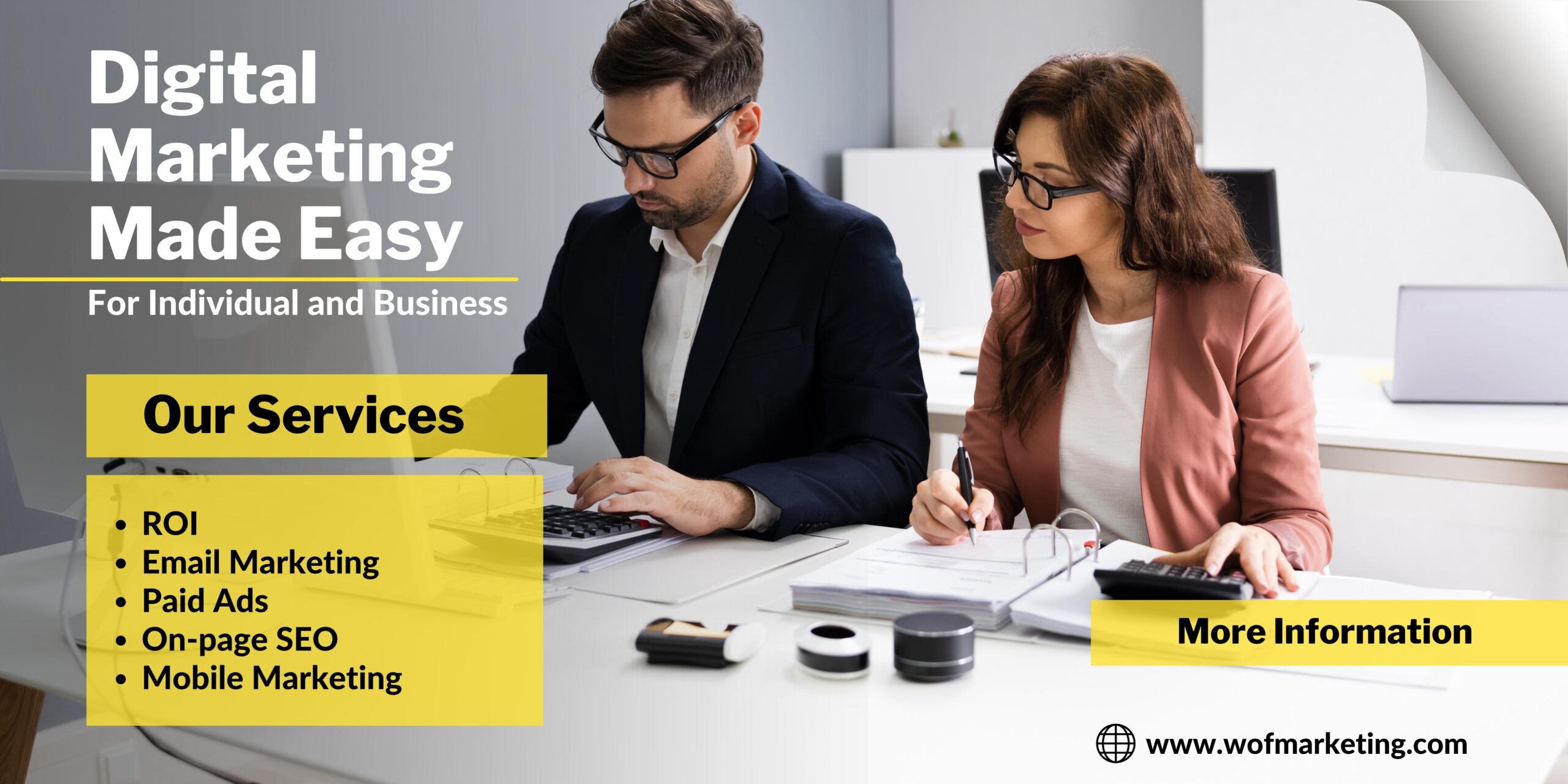Digital Marketing Made Easy: A Comprehensive Guide

In this comprehensive guide to Digital Marketing Made Easy, you will learn the simplest approach you never knew matters when it comes to online marketing. Join Alex and Jess as they sit down for a friendly chat on demystifying digital marketing. No jargon, just a conversation to make the world of online business a little more approachable.
Introduction
Welcome to the ultimate guide, where we unravel the mysteries of digital marketing, making it as easy as a Sunday morning. In this journey, we’ll explore the fundamental aspects that often go unnoticed yet make a significant impact on your online success.
So buckle up as we take you through the essentials with Alex and Jess, two curious entrepreneurs ready to decode the secrets of the digital world.
Digital Marketing Made Easy Guide
Marketing revolves around achieving a favorable Return On Investment (ROI). Choosing the best way to invest time and resources in learning digital marketing amid numerous options can be challenging.
For those seeking to promote events, services, or products, there are over 50 internet marketing methods to choose from. I can attest to this from personal experience, having experimented with various approaches.
Out of the multitude, I’ve identified 7 strategies that consistently deliver results over time.
These techniques have contributed to generating over $20 million in revenue for our clients and played a crucial role.
More significantly, these strategies are adaptable to virtually any industry and individual.
Implementing just one of these 7 online marketing strategies correctly can be a wise investment of your time and money. I encourage you to explore further details about the program to discover how it can benefit you.
1. Building a Strong Online Presence
Website Optimization:
Your website is the online face of your business. Ensure it is not only visually appealing but also user-friendly. Optimize loading times, make navigation intuitive, and create compelling content that engages visitors.
2. Digial Marketing Made Easy through Search Engine Optimization (SEO)
SEO is the backbone of digital marketing. Research and incorporate relevant keywords into your content, meta tags, and URLs to enhance your website’s visibility on search engines. Regularly update content to stay relevant in search engine rankings.
3. Digital Marketing Made Easy with Social Media Marketing:
Leverage the power of social media platforms to connect with your audience. Choose the platforms that align with your target demographic and create engaging content that sparks conversations and encourages sharing.
Social Media Platforms
- Facebook:
- Audience: With over 2.8 billion monthly active users, Facebook is a versatile platform suitable for businesses of all sizes.
- Marketing Features: Facebook allows businesses to create pages, run targeted ads, and engage with their audience through posts, comments, and Messenger.
- Content Types: Businesses can share a variety of content, including text posts, images, videos, and live broadcasts.
- Instagram:
- Audience: Known for its visual-centric nature, Instagram has over 1 billion monthly active users, making it ideal for brands with visually appealing products or services.
- Marketing Features: Instagram offers photo and video sharing, Stories, IGTV, and shopping features. Businesses can use influencers, sponsored content, and hashtags to enhance visibility.
- Content Types: Visual content, such as high-quality images and engaging videos, performs well on Instagram.
- Twitter:
- Audience: Twitter has around 330 million monthly active users and is particularly popular for real-time updates, news, and concise interactions.
- Marketing Features: Brands can use Twitter for tweet campaigns, hashtags, and engaging with their audience through retweets and replies. Twitter ads provide additional promotional opportunities.
- Content Types: Tweets are limited to 280 characters, making it essential to craft concise and engaging messages.
- LinkedIn:
- Audience: LinkedIn is a professional networking platform with over 700 million users, making it ideal for B2B marketing and professional networking.
- Marketing Features: Businesses can create company pages, share industry insights, engage in groups, and run targeted advertising campaigns.
- Content Types: LinkedIn is suitable for sharing professional articles, updates, and multimedia content related to business and industry.
- Pinterest:
- Audience: Pinterest has over 400 million monthly active users, primarily focusing on visual discovery and inspiration.
- Marketing Features: Businesses can create visually appealing pins, utilize boards to organize content, and participate in group boards. Pinterest Ads help boost visibility.
- Content Types: Ideal for sharing creative and visually appealing content, including infographics, DIY guides, and product showcases.
When choosing social media platforms for marketing, consider your target audience, the nature of your content, and your marketing goals. Diversifying your presence across relevant platforms can maximize your reach and engagement with different segments of your audience.
4. Digital Marketing Made Easy using Paid Advertising: Amplifying Your Reach and Impact
Paid advertising stands as a powerful tool to accelerate your brand’s visibility and engage with a targeted audience. This marketing approach involves paying for ad space on various platforms, ensuring your content reaches users who are most likely to be interested in your products or services.
Key Components of Paid Advertising
Google Ads
- Utilize Google’s vast network to display your ads when users search for relevant keywords.
- The pay-per-click (PPC) model ensures you only pay when users click on your ad, maximizing cost-effectiveness.
Social Media Ads
- Leverage the extensive user bases of platforms like Facebook, Instagram, and Twitter to showcase your brand.
- Target specific demographics, interests, and behaviours to enhance the relevance of your ads.
Display Advertising
- Place visual ads on websites within Google’s Display Network to reach a broader audience.
- Visual appeal is crucial; use compelling graphics and ad copy to capture attention.
Video Advertising
- Engage users with captivating video content on platforms like YouTube.
- Target audiences based on demographics, interests, and online behaviour.
Remarketing
- Reconnect with users who have previously interacted with your website or ads.
- Reinforce brand awareness and encourage conversions by tailoring ads to their previous interactions.
Benefits of Paid Advertising
- Targeted Reach: Pinpoint your audience based on demographics, interests, and online behavior.
- Immediate Impact: Unlike organic methods, paid ads offer swift visibility and can drive immediate traffic to your website.
- Measurable Results: Detailed analytics enable you to track the performance of your campaigns, allowing for data-driven optimizations.
Best Practices
- Clear Objectives: Define your goals, whether it’s brand awareness, lead generation, or direct sales.
- Compelling Creatives: Craft visually appealing and persuasive content to capture the audience’s attention.
- Continuous Optimization: Regularly analyze data, tweak targeting parameters, and refine your strategy for optimal results.
Paid advertising is not just about spending money; it’s a strategic investment to ensure your message is seen by the right people at the right time. By combining creativity with data-driven insights, you can create impactful campaigns that elevate your brand in the competitive digital landscape.
5. Digital Marketing Made Easy with Email Marketing: Nurturing Connections and Driving Conversions
Email Marketing remains a cornerstone of digital communication, offering a direct and personalized way to engage with your audience. This versatile tool empowers businesses to build relationships, nurture leads, and convert prospects into loyal customers.
Key Components of Email Marketing
Building and Segmenting Email Lists
- Develop a quality subscriber list by encouraging sign-ups through your website, events, or other touchpoints.
- Segment your list based on demographics, preferences, or behavior for targeted and relevant communication.
Crafting Engaging Email Campaigns
- Design visually appealing emails with compelling content that aligns with your brand voice.
- Utilize storytelling, personalized recommendations, and clear calls to action to encourage user interaction.
Automation for Efficiency
- Implement automated workflows for onboarding, lead nurturing, and customer retention.
- Save time and deliver timely, relevant content based on user actions and preferences.
Measuring and Analyzing Performance
- Utilize analytics tools to track open rates, click-through rates, and conversion metrics.
- Gain insights into user behavior to refine and optimize future campaigns.
Compliance and Personalization
- Adhere to data protection regulations (such as GDPR) to ensure subscriber consent and privacy.
- Personalize emails with the recipient’s name, preferences, and relevant content for a more engaging experience.
Benefits of Email Marketing
- Direct Communication: Reach your audience directly in their inbox, creating a personalized connection.
- Cost-Effective: Compared to traditional advertising, email marketing is a cost-effective way to communicate with a large audience.
- Segmented Targeting: Tailor content based on user segments, improving relevance and engagement.
- Measurable Results: Comprehensive analytics provide valuable insights for continuous improvement.
Best Practices
- Mobile Optimization: Design responsive emails that look great on both desktop and mobile devices.
- Compelling Subject Lines: Craft intriguing subject lines to entice recipients to open your emails.
- Consistent Branding: Maintain a consistent brand identity throughout your email campaigns.
- A/B Testing: Experiment with different elements (subject lines, content, CTAs) to optimize performance.
6. Analytics and Data-driven Decisions
Understand the importance of analytics in digital marketing. Explore tools for tracking and interpreting key metrics, allowing you to make informed decisions and continuously optimize your strategies.
7. Mobile Marketing: Capturing Audiences on the Go
In an era where mobile devices are an integral part of daily life, Mobile Marketing has emerged as a pivotal strategy for businesses to connect with consumers in a personalized and convenient manner. This dynamic approach leverages the power of smartphones and tablets to reach audiences on the move.
Key Components of Mobile Marketing
Responsive Design
- Ensure your website, emails, and content are optimized for seamless viewing on various mobile devices.
- Responsive design enhances the user experience and positively influences search engine rankings.
Mobile Advertising
- Utilize mobile-specific ad formats, such as interstitial ads, native ads, and in-app ads.
- Target audiences based on location, behavior, and demographics for precise ad delivery.
App Marketing
- Promote and optimize your mobile app for discoverability and user engagement.
- Leverage app store optimization (ASO) strategies to enhance visibility in app marketplaces.
Benefits of Mobile Marketing
- Widespread Reach: With the global adoption of smartphones, mobile marketing allows you to connect with a vast and diverse audience.
- Geo-Targeting: Reach users based on their location, enabling location-specific promotions and offers.
- Instant Accessibility: Mobile marketing ensures that your brand is accessible anytime, anywhere, providing immediate access to information and services.
- Interactive Engagement: Leverage features like push notifications, mobile-friendly forms, and interactive content to engage users effectively.
Best Practices
- Mobile-Friendly Content: Prioritize concise and visually appealing content suitable for smaller screens.
- Optimized Loading Speed: Ensure swift loading times for mobile pages and apps to minimize user frustration.
- Location-Based Marketing: Use geo-targeting to send relevant promotions or information based on the user’s location.
- Utilize Mobile Analytics: Leverage analytics tools to understand user behavior and optimize your mobile strategy.
The Future of Mobile Marketing
As technology continues to advance, so does the landscape of mobile marketing. Emerging trends such as augmented reality (AR), mobile video, and voice search present exciting opportunities for marketers to innovate and connect with audiences in new and immersive ways.
Mobile marketing isn’t just a strategy; it’s a necessity in a world where mobile devices have become an extension of our daily lives. By embracing this dynamic approach, businesses can ensure that their brand remains at the fingertips of consumers, providing valuable experiences that resonate in the mobile-centric landscape.
8. Social Media Management
Discover the nuances of effective social media management, including choosing the right platforms, developing a content calendar, and engaging with your audience to build lasting relationships.



